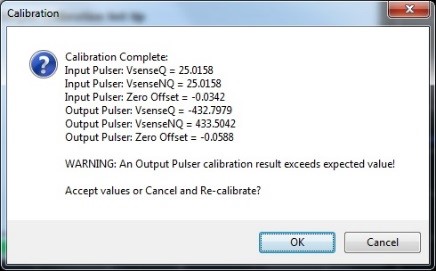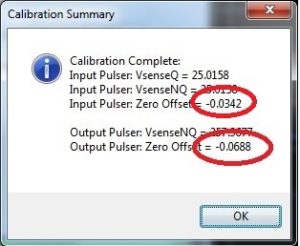This website uses cookies so that we can provide you with the best user experience possible. Cookie information is stored in your browser and performs functions such as recognising you when you return to our website and helping our team to understand which sections of the website you find most interesting and useful.
Symptoms / Solutions:
If a warning message appears after calibration, the calibration is not valid. Most likely a cable is not connected correctly or the pulse head failed to initialize. This could also mean that the pulse head EEPROM is not set correctly.

A correct calibration will not show a warning. A good indication of the accuracy of the measurement is to check the Zero Offset in the Calibration Summary window. The absolute value of this offset should be smaller than 1, ideally smaller than 0.1.

Additional Information:
After a calibration, the user should also verify the accuracy of the calibration. Disconnect all cal standard from the pulser and set various Q and NQ voltages in the Pulsed Adjustment Window. Verify that the DMM window displays approximately the same voltage that was set. Current (on an open) should be approximately zero. The current accuracy can be checked by connecting a calibration standard to the pulse head, apply a NQ (only NQ) voltage and check if the ratio of voltage and current on the on screen DMM is equal to the calibration standard resistance (using Ohm’s law). If the ratio holds, then you are ready to start testing devices.
Keywords: Auriga, Pulsed IV, calibration, verification
Last date modified: March 30, 2017
Ruggedness
Noise Measurements
Pulsed IV Systems
Device Modeling
Strictly Necessary Cookie should be enabled at all times so that we can save your preferences for cookie settings.
If you disable this cookie, we will not be able to save your preferences. This means that every time you visit this website you will need to enable or disable cookies again.
This website uses Google Analytics to collect anonymous information such as the number of visitors to the site, and the most popular pages.
Keeping this cookie enabled helps us to improve our website.
Please enable Strictly Necessary Cookies first so that we can save your preferences!

